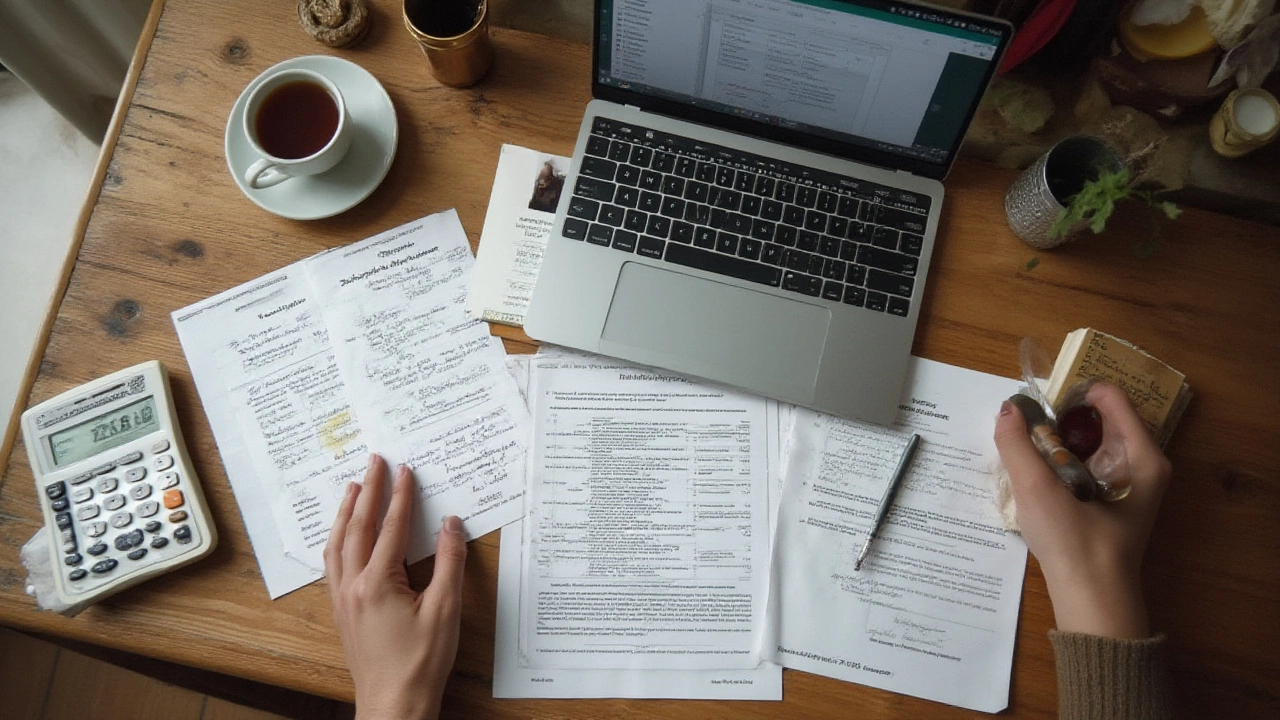Picture this: You’ve just landed the deal of a lifetime with your best friend for a start-up, or maybe you’re thinking of investing in your favorite coffee shop down the street. And then the question hits—how much of this do I actually own? You’d be surprised at how many people throw themselves into business without really knowing where they stand percentage-wise. Sadly, overlooking something as basic as share of ownership can trip up even seasoned folks. We’re breaking it all down, minus the stuffy explanations and number soup. Here’s the no-stress way to understand what you own, why it matters, and how to figure it out every time. Ready to finally nail down those numbers so they can’t turn around and bite you?
Understanding Share of Ownership: What Does It Actually Mean?
Let’s start with the basics, because most people have run into this at least once: Maybe you chipped in money for a group gift, split the rent, or went in on a family lottery ticket. When things go well (or sideways), the first thing anyone wants to know is who owns what. In business or investments, share of ownership is your slice of the pie. It’s usually talked about as a percentage, and it’s more than just a brag—your share means money, control, and a say at the table. If you own 50% of something, you call half the shots. If you own 30%, that’s less power, but you’re still a player.
Ownership splits can get messy, fast. Let’s say you and two friends split $10,000 to start a food truck: Amanda puts in $5,000, you throw in $3,000, and Gabe comes in last with $2,000. Simple, right? Here’s how you figure it:
- Add up the total investment ($5,000 + $3,000 + $2,000 = $10,000).
- Divide each person’s input by the total. Example: Amanda’s share is $5,000 / $10,000 = 0.5, or 50%.
- You get $3,000 / $10,000 = 0.3, or 30%.
- Gabe gets $2,000 / $10,000 = 0.2, or 20%.
Easy? Sure, when it’s just money. But what about ‘sweat equity’? What if Amanda did all the legal legwork and Gabe sold his rare Pokémon cards to help out? Now it’s more than just dollars. Sometimes sweat equity is valued and added to the ‘pool,’ and suddenly, those shares shift. The point: share of ownership isn’t just about money—sometimes it’s about what you bring to the table beyond cash.
Ownership matters for more than just splitting profits. A higher percentage can mean more voting rights. In companies, decisions require majority or supermajority approval. Bigger stakes can also mean a bigger slice if the company is sold, or a bigger responsibility if it runs into trouble. And if you want to sell your share, knowing exactly how much you own makes life a lot easier—trust me, I’ve watched friends squabble over a single percent. If there’s one thing to take away: get your share percentage down on paper, from day one, before any real money changes hands.
Large public companies and startups track every share precisely, sometimes down to fractional amounts, so no one’s left in the dark. If you’ve got stock options at work, or if a company issues new shares, those percentages can change—this is called ‘dilution,’ and you want to know about it! For example, if your company had 100 shares and you owned 10, you had 10%. If the company issues 50 more shares (total is now 150), you only own 6.67%. It stings unless everyone is on board with the plan. This is why knowing how to work out your share—and keep an eye out for dilution—is crucial.
| Owner | Investment | Share of Ownership (%) |
|---|---|---|
| Amanda | $5,000 | 50% |
| You | $3,000 | 30% |
| Gabe | $2,000 | 20% |
In family businesses, couples’ joint investments, or real estate partnerships, getting this right is the key to avoiding drama. People often assume they each get an equal share—until the numbers are actually crunched. If all three food truck founders above split it 33-33-34 just for convenience, that could lead to fights later when someone wants to cash out or make a big decision. Don’t guesstimate; calculate. Every time.

How to Calculate Share of Ownership: Step-by-Step, With Real-Life Examples
Let’s not make this harder than it needs to be. At its core, the *calculate share of ownership* question boils down to a simple formula:
- Your contribution (money, assets, or agreed value) divided by the total value of the business or asset, times 100 to get a percentage.
Seems basic, but mistakes are easy when you toss in loans, equipment, or labor. Let’s walk through some common setups. I promise you’ll never want to eyeball these numbers again after you see how mistakes here can spiral.
Example 1: Simple Business Partnership
Three friends open a dog grooming biz. Bella would love all the attention, by the way. Each contributes:
- Cash: $10,000 (Maya)
- Truck: $5,000 value (Sam)
- Equipment: $5,000 value (Jordan)
Total pot: $10,000 + $5,000 + $5,000 = $20,000
Ownership:
- Maya: $10,000 / $20,000 = 50%
- Sam: $5,000 / $20,000 = 25%
- Jordan: $5,000 / $20,000 = 25%
If Maya later sells her 50% for $15,000, the new buyer gets her rights and voting power.
Example 2: Adding a New Partner
Suppose your company is rolling, and Lisa wants in. The business is now worth $30,000. Lisa offers $10,000 for a seat at the table. Here’s what happens:
- Total new value: $30,000 + $10,000 = $40,000
- Lisa now owns $10,000 / $40,000 = 25%
- The rest (original owners): $30,000 / $40,000 = 75% split as before
Your existing shares shrink percentage-wise, but the business is worth more, ideally making everyone richer. Watch for this in property too. If an investor buys into your house, ownership shares must be recalculated every time someone adds cash or value.
Example 3: Sweat Equity
Let’s say Alex brings no cash, but runs daily operations for a year. The team decides her time is worth $7,500. If the original pot was $20,000 (like above), it’s now $27,500. Alex owns $7,500 / $27,500 = about 27.27%. Others recalculate their shares based on the same new total. Don’t forget to put this in writing. Thousands of start-ups have been torn apart by someone’s “unofficial” promise of equity.
Here’s another twist—what about company shares? Let’s say a small business issues 1,000 shares. Linda owns 650, Rosa holds 350. It’s clean and easy. But if Linda sells 100 shares to Max, things change:
- Linda: 650 - 100 = 550 shares
- Rosa: 350 shares
- Max: 100 shares
Total shares: still 1,000. Linda now has 55%, Rosa 35%, Max 10%. A good cap table (the sheet where everyone’s shares are listed) keeps arguments off the table. In tech startups, this table grows complicated fast with investors, employees with stock options, or rounds of funding. But the formula never changes: shares you own divided by total shares outstanding.
One famous example: Mark Zuckerberg owned about 28% of Meta (Facebook’s parent) as of 2024, but had voting rights over nearly 58% of the company through special shares. Not all shares are the same! Always check for preferred versus common stock, and what each actually lets you do.
Don’t forget taxes. When you get a bigger share, you might owe taxes on the increased value. Check the rules in your country. In the US, equity is often taxed when shares vest or when you sell.
| Scenario | How to Calculate |
|---|---|
| Simple Investment | Individual’s input / Total investment |
| Sweat Equity | Assigned value of effort / Total business value (cash + sweat equity) |
| Company Shares | Shares owned / Total shares outstanding |
Tracking share of ownership regularly is wise, especially after issuing new shares, swapping assets, or taking on loans convertible into equity. I keep a spreadsheet for my own small projects, updating every time a penny moves.

Smart Tips to Manage Your Ownership (and Stay Sane)
Once you know how to *calculate share of ownership*, staying on top of things matters as much as the math itself. Here’s what you absolutely don’t want to skip:
- Write Everything Down: I know, paperwork is a drag, but handshakes alone are a disaster waiting to happen, especially when there’s actual money at stake. Have a clear, signed deal or agreement spelling out each person’s ownership in actual numbers—not just “roughly a third.”
- Review Ownership Regularly: Every time someone leaves, joins, buys, sells, or even loans the business money, check your splits. If your group wins the lottery and someone buys extra tickets, that changes their stake. More formal companies call this “updating the cap table.”
- Understand Shares vs. Control: Sometimes, holding 10% of shares doesn’t mean you get 10% of the vote. Some companies give stronger voting power to founders, or “preferred” shareholders. Ask for clarity before you part with cash—always.
- Plan for Dilution: If your business might grow and bring in new cash or people, be ready for shares to shrink. Get advice on how dilution can play out. In a recent Y Combinator report, over half of founders said they didn’t realize how much their stakes would shrink by the time investors joined.
- Don’t Mix Business and Friendship Without Boundaries: You wouldn’t let a friend borrow your car with no rules. Don’t go into business without mapping out what happens if things go south. It’s not pessimistic, it’s honest. My best friend and I have a clear plan for our pet-sitting hustle, down to the last percentage—even Bella has a say (well, sort of).
- Ask for Help: Calculators, templates, or a quick chat with a financial advisor can save you a ton of stress. There are plenty of online tools that let you plug in numbers and get your exact percentage—just search “ownership calculator” or “equity calculator.”
Handling family or small business equity isn’t just about numbers, it’s about trust. Numbers keep the trust honest. Each year, small business partnerships fall apart because a change wasn’t tracked or someone’s “share” was never truly nailed down. Don’t let that be you. Sitting down for five minutes to do the math can save months of headaches—or worse, a ruined friendship. I’d rather spend that time at the dog park with Bella, honestly.
At the end of the day, your share of ownership defines your future with the business, your slice of the profit, your voting rights, and even your day-to-day role. Every percent matters, whether you’re building a billion-dollar app or just splitting the bills with roommates. Master the formula, double-check your numbers, keep everything recorded, and never settle for “close enough.” You’ll thank yourself the moment decisions—and dollars—are on the line.
